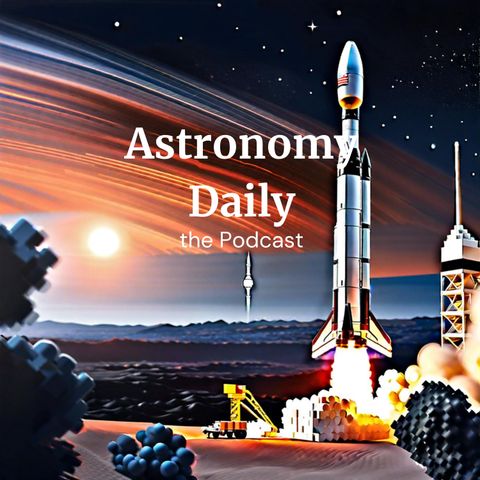Embark on a celestial journey with today's episode of Astronomy Daily - The Podcast, where your host, Anna, brings you the latest cosmic updates. We'll dive into the successful launch of SpaceX's Starlink satellites, incredible new images from the Hubble Space Telescope, and the real-time awakening of a massive black hole. We'll explore how Earth's atmosphere protects us from the devastating effects of nearby supernovae and look at a fascinating collaboration between Lego and space agencies to celebrate upcoming lunar missions. Stay tuned for an engaging and insightful episode as we dive into some of the most intriguing stories this week.On June 18, SpaceX successfully launched another batch of its Starlink broadband satellites from California, marking the 61st orbital liftoff of the year for the company. A Falcon 9 rocket carrying 20 satellites lifted off from Vandenberg Space Force Base at 11:40 p.m. EDT. This launch included 13 satellites with direct-to-cell capabilities, making them even more adaptable for broadband communication. Eight and a half minutes after launch, the Falcon 9's first stage made a pinpoint landing on the drone ship "Of Course I Still Love You" stationed in the Pacific Ocean. This was the fifth flight and landing for this particular booster, highlighting SpaceX's commitment to reusability and cost efficiency in space travel. The rocket's upper stage continued its journey to deploy the 20 satellites into low Earth orbit, adding to the ever-growing Starlink mega constellation, which now boasts over 6000 operational satellites.NASA's Hubble Space Telescope has successfully captured its first new images since switching to a single gyro operational mode. Despite issues with one of Hubble's gyroscopes, the transition to single gyro mode has proven effective, allowing Hubble to resume its vital scientific missions. One of the standout achievements in Hubble's new operational mode is a stunning image of the galaxy NGC 1546, located in the constellation Dorado. This image is part of a collaborative observing program involving both Hubble and NASA's James Webb Space Telescope. The program also employs data from the Atacama Large Millimeter/submillimeter Array, providing scientists with a comprehensive and detailed view of stellar formation and evolution.NASA has announced that Boeing's Starliner capsule will remain docked at the International Space Station for an additional four days, postponing its return to Earth until June 26. The extension will provide valuable time to gather more comprehensive data from this 20-day test flight, which is the first to carry astronauts aboard the Starliner. This delay comes as a precautionary measure to address ongoing technical challenges. The Starliner has experienced five known helium leaks in its propulsion system and has faced unexpected issues with numerous maneuvering jets. Engineers have determined that the spacecraft still has ample helium reserves to ensure a safe trip back to Earth. Meanwhile, astronauts Barry "Butch" Wilmore and Sunita Williams will use the extra time to contribute to ISS operations, aiding with experiments and maintenance tasks.In an extraordinary breakthrough, astronomers have reportedly documented what might be the first real-time observation of a massive black hole awakening. The galaxy SDSS J1335+0728, which appeared unremarkable in years past, began to shine brighter than ever starting in late 2019. Scientists tracking this phenomenon use data from multiple space and ground-based observatories, concluding that the significant behavioral changes are likely due to the sudden activation of the galaxy's central black hole. This groundbreaking observation could offer new insights into the mechanisms and behaviors inherent to galactic cores.New research confirms that Earth's atmosphere, especially the ozone layer, plays a critical role in protecting life from the harmful effects of nearby supernovae. The ozone layer, along with the magnetosphere, acts as a formidable shield against the intense UV radiation and cosmic rays that accompany these massive stellar explosions. A study published in Nature Communications Earth and Environment reveals that even a nearby supernova explosion within 100 parsecs, or 326 light-years, would not significantly harm Earth's biosphere. This resilience underscores the robust nature of Earth's defenses, allowing its biosphere to thrive even amidst galactic phenomena.LEGO, in partnership with ESA and NASA, is celebrating the Artemis program by releasing special space-themed bricks. This collaboration aims to inspire the next generation of space enthusiasts and commemorate the upcoming missions to the moon. The Artemis program's goal is to return humans to the lunar surface for the first time in over 50 years. These unique LEGO sets will not only capture the imagination of children and adults alike but also help raise awareness and excitement for future space exploration endeavors.
For an astronomical experience, visit our website at
astronomydaily.io for the latest news, sign up for our free newsletter, and check out exclusive sponsor deals.
Connect with us on Y
ouTube, TikTok, X, and Facebook via @AstroDailyPod for engaging discussions with fellow space aficionados. This is Anna, reminding you to keep your gaze fixed on the heavens. Until our next stellar episode, let the cosmos ignite your curiosity and wonder. Clear skies and cosmic discoveries to all!
Support:This podcast is better with your support:
https://www.bitesz.com/show/astronomy-daily-the-podcast/support/www.bitesz.comSponsors:www.bitesz.com/nordpasshttps://www.bitesz.com/show/astronomy-daily-the-podcast/sponsors/

